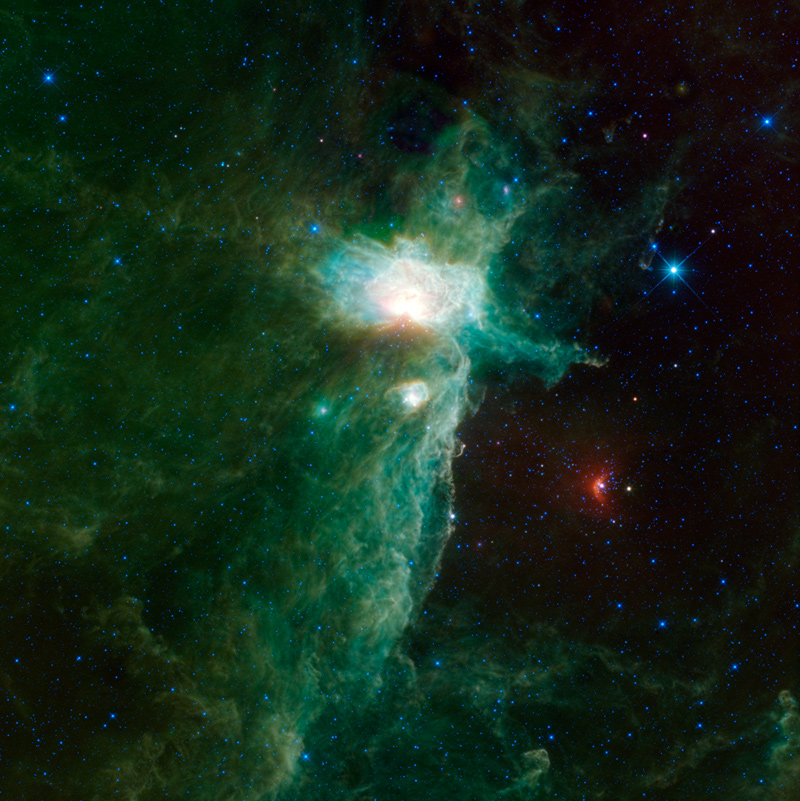The above image shows the Flame Nebula (NGC 2024 and Sh2-277), which sits on the eastern hip of the constellation Orion, the Hunter. Orion is most easily visible in the northern hemisphere during winter evenings. Image
Credit: NASA/JPL-Caltech
Take a look at this! It's a new image from NASA's Wide-field Infrared Survey Explorer (WISE), which shows
the candle-like Flame Nebula (NGC 2024 and Sh2-277) lighting up a cavern of dust. The Flame is
part of a region known as the Orion complex, a turbulent star-forming area located near the belt of the constellation Orion, the Hunter.
The WISE mission team released this image Monday, July 2nd, along with a new batch of data. Last March, the team released its all-sky catalog and atlas containing
infrared images from its first scan and data on more than a half billion objects, including
everything from asteroids to stars and galaxies. Now, the mission is offering up
additional data from its second scan of the sky. According to WISE principle investigator Edward (Ned) Wright of UCLA, data from the second sky scan are useful for studying
stars that vary or move over time, and for improving and checking data from the
first scan.
In this WISE view of the Flame, colors are assigned to
different channels of infrared light. The resulting image looks like a flaming
candle giving off billows of smoke. In fact, the wispy tendrils in the image
are part of the larger Orion star-forming complex, a huge dust cloud churning
out new stars. In the Flame, massive stars are carving a cavity in this
dust. Intense ultraviolet light from a central massive star 20 times heavier
than our sun, and buried in the blanketing dust, is causing the cloud to glow in
infrared light. This star would be almost as bright to our eyes as the three
stars in Orion's belt, but the dust makes the star appear 4 billion times
fainter than it really is.
Other features in this view include the reflection nebula NGC 2023, seen as a bright
circle in the lower half of the image, and the famous Horsehead Nebula, which is
hard to see but located to the right of one of the lower, vertical ridges. The
bright red arc at lower right is a bow shock, where material in front of the
speeding multiple-star system Sigma Orionis is piling up.
The data released July 2nd cover about one-third of the mission's second full
scan of the sky. They were taken from August to September 2010 as the telescope
began to deplete its coolant, operating with three of its four infrared
detectors. The coolant kept the telescope chilled to prevent its heat, or
infrared radiation, from interfering with the observations. As the telescope
warmed during this period, one of the four channels on WISE was overwhelmed by
the infrared radiation. An introduction and quick guide to accessing the WISE
all-sky archive for astronomers is online at: http://wise2.ipac.caltech.edu/docs/release/allsky/
.
And now, the WISE mission particulars...
Launched into Earth orbit December 14, 2009, NASA's Wide-field Infrared Survey Explorer (WISE) mission performed an all-sky survey in 3, 5, 12, and 22 µm wavelength range bands, over 10 months. WISE made its observations using its 40 cm (16 in) infrared telescope. The length of the initial mission was limited by the spacecraft's hydrogen coolant. A secondary post-crygenic mission continued for four months. During its time of operation, WISE completed two scans of the sky. On February 17th, 2011, WISE was decommissioned/hibernated when its transmitter was turned off.
NASA's Jet Propulsion Laboratory, Pasadena, California, manages, and operated,
WISE for NASA's Science Mission Directorate. Edward (Ned) Wright is the mission principal investigator and is at UCLA. The
mission was selected competitively under NASA's Explorers Program managed by the
agency's Goddard Space Flight Center in Greenbelt, Maryland. The science instrument
was built by the Space Dynamics Laboratory in Logan, Utah. The spacecraft was
built by Ball Aerospace & Technologies Corp. in Boulder, Colorado Science
operations and data processing take place at the Infrared Processing and
Analysis Center at the California Institute of Technology in Pasadena. Caltech
manages JPL for NASA. You can learn more about WISE mission online at http://www.nasa.gov/wise, http://wise.astro.ucla.edu and http://jpl.nasa.gov/wise .
To catch postings for all my blogs, subscribe on Twitter to @RoamingAstro . Like what you see? Let me know! Email: RoamingAstroInput@gmail.com .
-

No comments:
Post a Comment